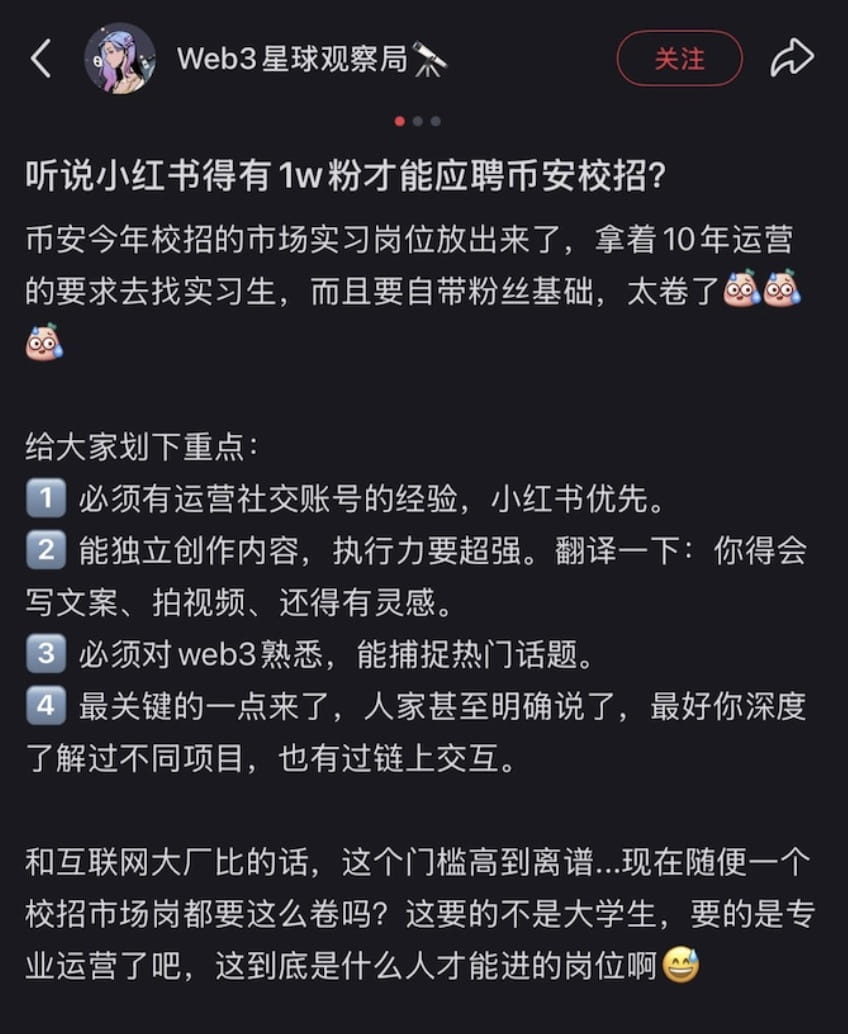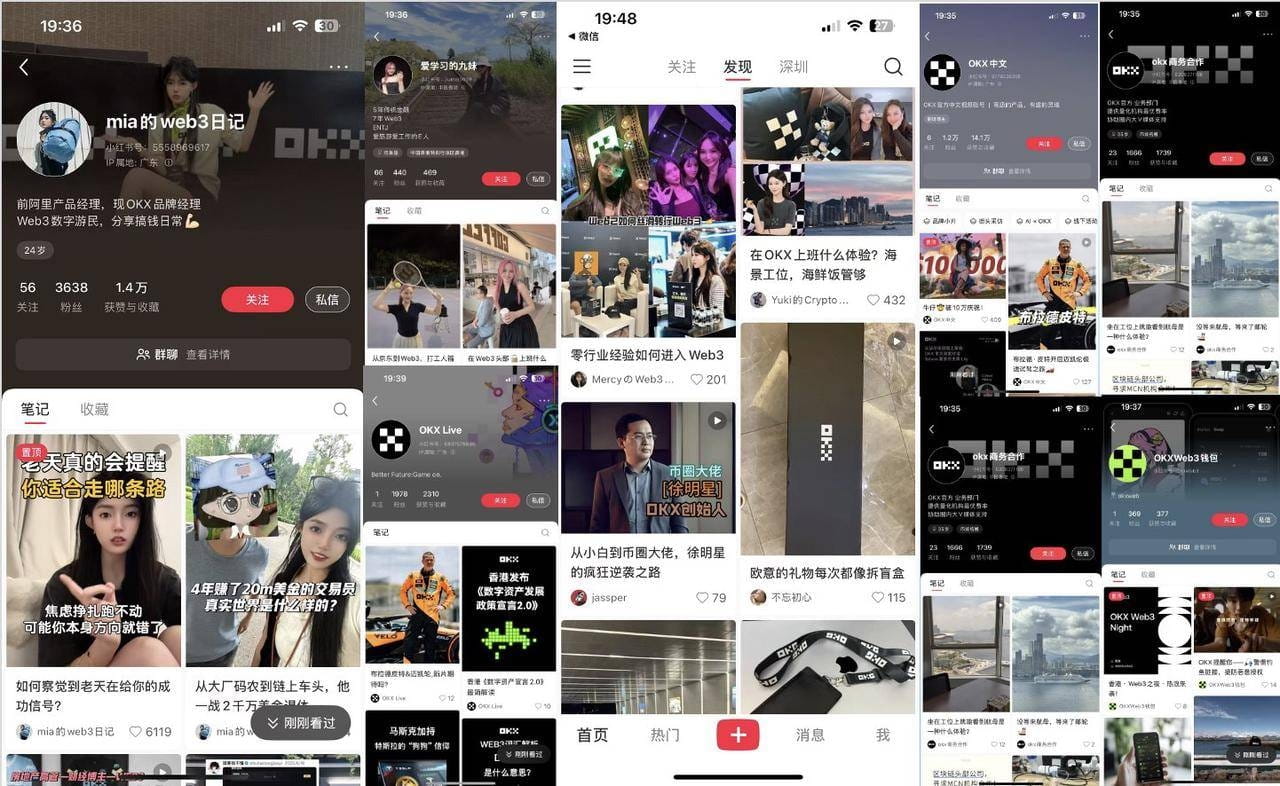Written by: Ada, Shenchao TechFlow
'I heard Xiaohongshu requires 10,000 followers to apply for Binance campus recruitment?'

A screenshot from Xiaohongshu blew up in a crypto job-seeking group.
'Harder than a 985 degree,' someone joked in the comments.
In fact, there is no 'hard fan threshold' in Binance's official JD, but it clearly states: 'Those with successful experience in operating social media accounts are preferred, especially in video, Xiaohongshu, and AI-related content areas.'
This is no mere joke. Crypto KOL 'AB Kuai.Dong' bluntly stated on X (Twitter):
'The attitude of major exchanges towards Xiaohongshu has shifted from 'should we do it' to 'can we do it big,' and now they even specifically recruit fresh graduates with experience in starting accounts on Xiaohongshu.'
From Weibo, Twitter, and Douyin to today's Xiaohongshu, the marketing battleground for exchanges is quietly shifting.
This shift is not a momentary impulse.
Between 2023 and 2024, the user profile of Xiaohongshu underwent a key change: content related to investment and financial management, overseas living, and remote working experienced exponential growth; users aged 25-35, from first and second-tier cities, and with a bachelor's degree or higher accounted for over 60%.
These individuals are precisely the core users that cryptocurrency exchanges most want to compete for.
On this platform that started with beauty and fashion, exchanges cautiously probe the platform's boundaries, packaging their 'ambitions' with street interview videos, workplace stories, and wealth notes.
Is Xiaohongshu really a new growth paradise for the crypto industry?
History of crypto traffic migration
To understand why exchanges are betting on Xiaohongshu, one must first grasp a 'history of crypto traffic migration'.
In the memories of many old crypto circle members, Weibo has long been the center of public opinion in the Chinese crypto world.
Between 2017 and 2022, senior executives from various exchanges engaged in a public battle on Weibo, tearing into each other, competing for personas, and making bold statements, resembling an 'open arena' for the industry. Many newcomers also completed their first transactions through the popular science and calls to action of Weibo's crypto bloggers.
At that time, whenever Bitcoin surged, a certain exchange would spend money to buy trending topics on Weibo, allowing entries like 'Bitcoin skyrockets' to climb the charts, attracting countless retail investors to watch.
However, everything came to a halt after regulation was implemented. With policies tightening, industry OG accounts like Sun Yuchen and He Yi were shut down, and a large number of KOLs were completely cleared out. Various factions were forced to migrate, ultimately gathering in today's X (Twitter), forming a new Chinese crypto social circle.
Today, X (Twitter) is undoubtedly the largest 'square' in the crypto world—Vitalik releases updates on Ethereum upgrades here, CZ responds to doubts here, and various KOLs engage in debates here. But the problem lies precisely here: it is too 'insider.'
After years of traffic competition, potential new crypto users have already been completely divided among KOLs with invitation links, and today's market resembles a tug-of-war between existing users.
For many Chinese-speaking users, Twitter has always been separated by a glass wall, unable to reach the sinking market or engage a broader audience.
Douyin was also once seen as a potential 'gold mine of crypto traffic'. It has unparalleled content explosiveness, but the problem is: this explosiveness is hard to solidify.
Fast-food style content consumption makes it difficult to establish the trust needed for financial products.
'The lifecycle of Douyin content is too short,' commented new media analyst You Mu Zhi. 'Its original design was for exposure and traffic, not trust. Once it leaves Douyin, its vitality quickly diminishes, and its influence is hard to embed into users' daily lives.'
Bilibili once hosted educational content from exchanges, from 'Cryptocurrency Knowledge' to 'Strategy Teaching', serving as a window to capture new users.
Similar to the challenges faced by Weibo, as regulation tightens, terms like 'Bitcoin' and 'exchange' have been systematically limited, leaving creators exhausted, and the exchanges' placements have gradually lost stability.
Unlike these old battlegrounds, Xiaohongshu has quietly but completely evolved over the past two years.
This is no longer just a community for sharing beauty and fashion. Content related to investment, financial management, technology exploration, and overseas living is growing exponentially, with users aged 25-35, with a bachelor's degree or higher, from first and second-tier cities accounting for over sixty percent.
These individuals are precisely the core clientele that crypto exchanges dream of capturing.
More importantly, the traffic distribution method of Xiaohongshu is completely different from that of Douyin.
It does not rely on the monopoly of top bloggers but allows KOCs with only 1,000 followers to gain significant exposure. For example, a post from an ordinary user on Xiaohongshu saying 'Bybit can still open an account, hurry up' can receive thousands of likes and interactions.
Another secret weapon of Xiaohongshu is its natural 'trust chain'.
Unlike public domain traffic platforms, Xiaohongshu's community is centered around human connection. Users interact with bloggers in the comments, consult privately, or even pull them into group chats, making the whole process feel like a word-of-mouth recommendation among friends rather than a cold advertisement.
For high-threshold, high-learning-cost crypto products, this chain means a shorter conversion distance.
A research report from Xinbang even referred to Xiaohongshu as the 'trust engine of social e-commerce':
It integrates the traffic of influencers, the information flow of sales, and the attributes of consumer opinion leaders, relying more on users actively searching rather than platform recommendations, making sales conversion more precise and less likely to provoke dislike.
Thus, when we see Binance, OKX, and Bitget starting to allocate resources to Xiaohongshu, it is not a temporary whim but a strategic bet conforming to the new traffic logic.
The secret growth strategies of exchanges.
'OKX slashed more than half of its KOL advertising budget on Twitter and began to invest heavily in Xiaohongshu. Several departments internally are working on Xiaohongshu, and almost the entire Chinese department is focused on Xiaohongshu.'
Crypto bloggers are unafraid to expose on X.
On Xiaohongshu, a 'Beijing Film School Flower' themed street interview video from OKX racked up over 87,000 likes. Similar street interview themes almost always easily break ten thousand likes, and the Nezha series of AI shorts can also garner thousands of collections.
OKX clearly does more than just shoot videos. Its approach on Xiaohongshu resembles a meticulously planned marketing layout: official accounts generate topics, employee accounts infiltrate various content layers, and a matrix-style penetration occurs.
In addition to official accounts, employees like Jiu Mei, Mercy, and Mia have accumulated a large number of fans with workplace narratives such as 'Insights on Switching to Web3' and 'Daily Life in an Exchange.' They seem independent but frequently interact with official accounts in the comments, creating secondary exposure for the brand and closing the distance.

This matrix strategy can hedge against account bans on one hand, and on the other, it allows brands to penetrate more segmented audience pools, such as young professionals wanting to enter Web3 or freelancers pursuing the 'digital nomad' lifestyle.
However, for exchanges, the role of Xiaohongshu may not just be to acquire direct registered users. More often, it plays the role of a 'brand showcase'—allowing potential users to familiarize and recognize the exchange brand through content, so when they actually have trading needs, they can think of it first.
Efficient conversions often occur in the 'underground world.'
Multiple grassroots studios have long been active on Xiaohongshu, tirelessly posting traffic-attracting notes.
These notes often disguise themselves as 'pitfall avoidance guides,' 'financial diaries,' or 'beginner tutorials,' attracting users to join groups or chat privately, then tossing out registration links. Once users deposit money and start trading, these promoters can earn a long-term commission income, and some studios even directly place registration ads on Xiaohongshu—this is also one of the most stable gray businesses in the crypto circle.

On Xiaohongshu, cryptocurrency is often not seen as a cold financial tool, but rather packaged as a choice of lifestyle.
Instead of saying 'invest in cryptocurrencies,' one says, 'how I achieved a passive income of over 10,000 a month'; instead of discussing K-line charts, one talks about the financial insights of digital nomads; instead of discussing technical analysis, one discusses the path to financial freedom for Gen Z...
This 'lifestyle' packaging perfectly fits Xiaohongshu's content ecology and lowers the psychological barrier for users.
Crypto blogger Viki summarized the current business-value-generating Web3 account types on Xiaohongshu:
Career consulting category: sharing career transition experiences to attract job seekers;
Investment insights category: seemingly lifestyle records, but essentially investment tutorials;
Lifestyle category: stories of digital nomads, remote work, and overseas living;
Personal IP category: establishing trust through strong identity labels.
'Exchanges will collaborate with KOLs or KOCs who have these four types of accounts, ultimately guiding them into communities and completing conversions through registered commission links,' Viki explained.
Behind this, exchanges are attempting to achieve a long-term brand reshaping: transforming from cold trading tools to community companions, or even 'narrative leaders.'
Dancing on thin ice
The influx of crypto exchanges into Xiaohongshu may seem like the first step to stepping out of 'crypto jargon' and into the mainstream social context, but this road is not smooth.
Trader 'Coin Poison' with 50,000 followers on Twitter bluntly stated that doing Xiaohongshu is 'extremely low cost-effectiveness.' He had to create numerous accounts and faced repeated bans, paying the price of over 20 accounts before grasping the rules.
'Back then, the industry hadn't become so competitive. Now, every exchange is crazily entering the platform, and traffic is no longer a blue ocean.' Another KOL, 'Digital Frenzy,' stated that doing Xiaohongshu now feels like 'being trapped in a walled city,' as the period of dividends has disappeared.
In addition to fierce competition, the platform's review mechanism is also a high wall.
'Low traffic yields no results, while high traffic triggers manual review,' Viki summarized. 'Once there are multiple violations, light penalties include limited traffic, heavy penalties include account bans; creating content feels like dancing with shackles.'
To avoid pitfalls, many creators have to adopt unique strategies for different stages, from copywriting and layout to traffic design, further lowering the return on investment.
The more challenging aspect is compliance and user cognition risk. The mainstream user group of Xiaohongshu is mostly young people who lack awareness of contracts, leverage, and on-chain assets. A small mistake can lead to misleading information causing financial losses, thereby triggering tighter regulations. Even though the platform currently maintains a certain level of ambiguity regarding crypto content, as financial content regulation becomes standardized, any public opinion explosion could lead to a complete ban.
The risks are evident, but exchanges are still willing to invest heavily.
A marketing manager from an exchange said, 'If you don't act, your competitors will get ahead.'
This is reminiscent of a classic 'prisoner's dilemma':
If you are the only one doing it, you can indeed reap the dividends.
If everyone does it, the dividends are diluted, and the risks are magnified.
If you don't do it, you watch your competitors harvest users.
So even knowing there are traffic traps and potential risks, one must still jump in.
Breaking the circle always comes at a cost; the question is whether this cost is worth it.
The exchanges' adventures on Xiaohongshu feel like dancing on thin ice—every step could be the last, yet when the music plays, no one wants to stop.
How long will this traffic carnival last? No one knows the answer.
The only certainty is that in today's world of increasingly expensive traffic and stricter regulations, the era of 'easy money' has permanently passed. Exchanges need to consider not just how to acquire users, but also how to genuinely create value under compliance and sustainability.
Otherwise, today's Xiaohongshu might be tomorrow's Weibo.
History does not repeat itself, but it always rhymes.



